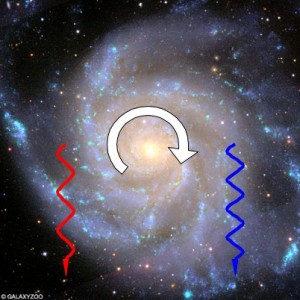Physicist: The most common answers are: “heavy neutrinos” and “I don’t know, something else?”. Neutrinos are, for lack of a better word, “ghost” particles, which makes them a decent candidate.
The original dark matter theories came from observations of nearby galaxies. By using the Doppler effect we can detect how fast stars are moving toward or away from us.

The Doppler Effect: Stars moving toward us look bluer, stars moving away look redder.
By graphing the speed of stars vs. their distance from the core of their galaxy you can determine how matter is distributed in that galaxy. This technique has revealed two interesting things: galaxies have about ten times more mass than you’d expect (from adding up stars and dust), and that even flat galaxies (like ours) have most of their mass arranged in a ball shape. The first result implies immediately that there’s matter out there that we can’t see. The second result (spherical distribution) implies that this matter is weakly- or non-interacting. Here’s why that makes sense:
All the particles in a cloud of matter (dust or gas or whatever) more or less orbit the center of the cloud. If those particles can interact, they will collide with each other and accrete. This means the cloud will tend to flatten into a disk, as well as collapse in on itself as it loses energy. This is a very common image for anyone who’s spent time looking at space pictures.

Saturn, Uranus, the Sombrero Galaxy, and the Andromeda Galaxy
A non-interacting cloud has no reason to do anything other than sit there being round. So, there’s the source of the theory. This “stuff” is so non-interacting, that light doesn’t even bounce off of it, so it’s invisible. But it creates gravity so it must have lots of matter. Hence the name, “Dark Matter”. Another, less popular name is “WIMPs” (Weakly Interacting Massive Particles). Many physicists are uneasy about dark matter because, by definition, it’s very difficult to detect. But the computer simulations of galaxies forming under the influence of Dark Matter tend to give results more consistent with the galaxies we can see in the sky today.
There are some alternative theories to dark matter, such as Mo.N.D. (Modified Newtonian Dynamics, which claims that gravity has slightly different rules at very low intensity), but they tend to be even less popular than dark matter.







Could it be related to parallel Universes?
http://www.naturalnews.com/040094_dark_matter_parallel_universe_milky_way.html
when the Big Bang started the nascent universe contained high energy photons. As it expanded it’s energy density dropped. But that would not constitute cooling as it would still contain high energy photons that could rattle around forevermore. So have the expansion stretch the photons and the energy lost show up as mass, what we call dark matter. And so we get the Cosmic Microwave Background Radiation that has been stretched around 1100 times.
This is, in a nut shell, my theory for the creation of dark matter.